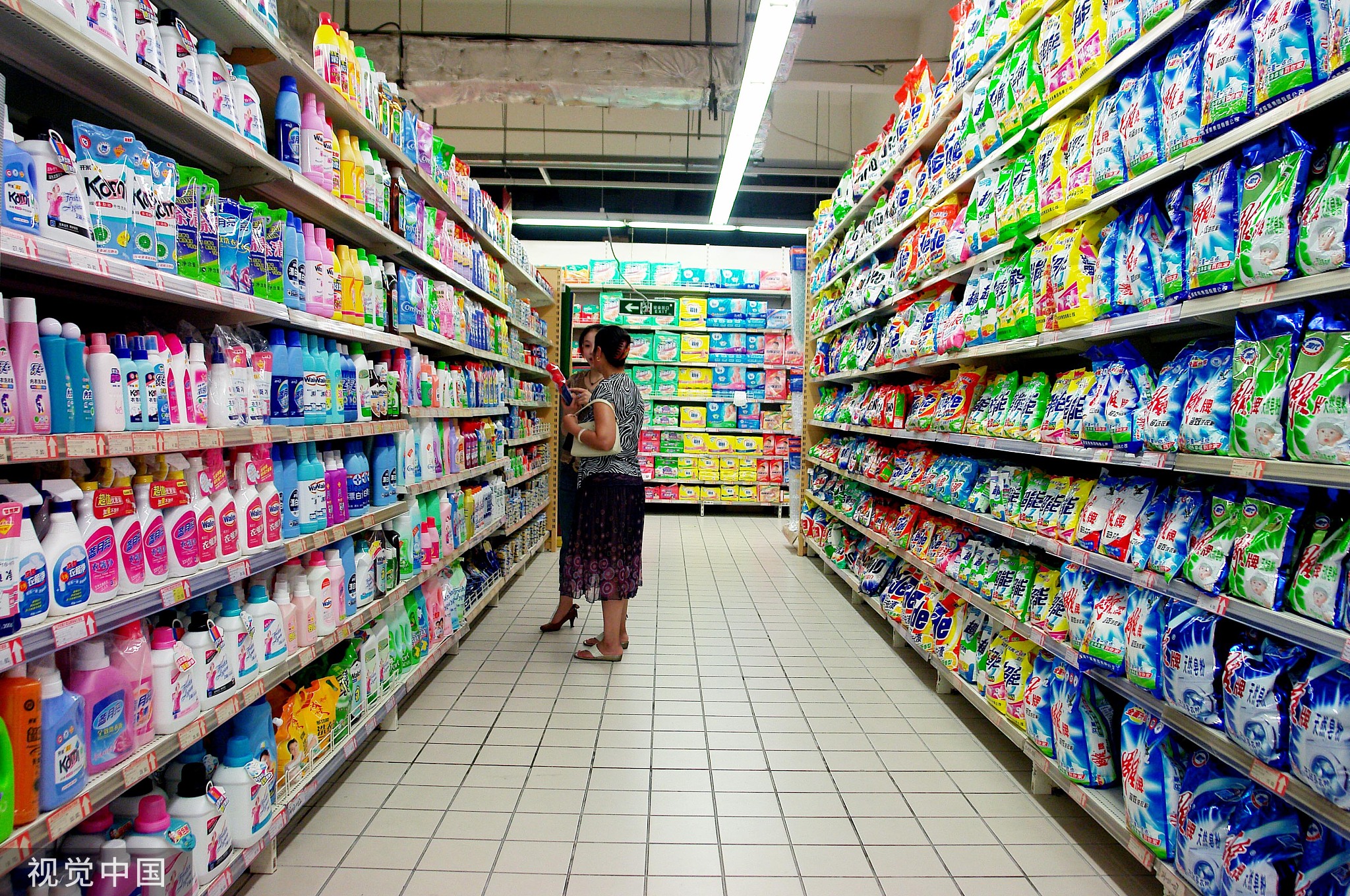漂白剂是为了额外消毒[23],衣物消毒剂也能达到这个目的。怕漂白剂伤害衣服的可以选择彩漂,对衣服更柔和一点,里面的有效成分是活性氧。波恩大学的研究中,使用含活性氧的洗涤剂后,杀菌效果明显提升[19]。
市面上很多洗衣液也标注了抗菌功能,可以吗?
中国抗菌抑菌洗涤剂的行业标准(QB/T 2850-2007)只规定了抗菌性洗涤剂的杀菌率需要超过90%,但却没有规定必须要杀死真菌。对于饱受真菌折磨的人来说,这根本达不到要求。

2007年8月13日, 郑州一超市,消费者正在各个品牌 的洗衣液、洗衣粉中选择 。但是市面上的这种洗衣液却根本无法满足真菌患者对杀菌的需求
最后,我们还可以学习发达国家的两样洗衣真经:热水和烘干。
热水本身就能杀除微生物,还能激发漂白剂的潜力。在52℃下洗15分钟,袜子上的微生物就不会出现在别的衣服上[19]。但是前提是在清洗过程中保持水温,有加热功能的洗衣机可以实现。
当然如果执意要用冷水洗衣服,为了不出现交叉感染,你需要加入漂白剂并洗45分钟以上[19]。
最后就是烘干。晾晒对真菌的伤害有限。遇到阴雨天气不能及时干燥,过程中真菌会繁殖。干燥后,它们也有能力潜伏在衣服上。烘干就能进一步杀灭残留在衣服上的病菌[26],在高温和快速脱水的双重制裁下,让它们没有喘息的机会。

2019年2月10日,江西省都昌县,南方地区阴雨连绵难觅阳光,图为透过车窗拍摄的在鄱阳湖岸边的人们。这种阴雨天气,阳光杀菌很难做到,买一个烘干机是最便利的选择
所以,对于出现真菌感染、或免疫力低下、或经常接触病原体的高风险人群,为了自己和家庭成员着想,最好买一个烘干机。为了健康,再谨慎也不为过。
别问有没有购买链接了,连这么长的文章都看完了,买个适合自己的洗衣机烘干机还能难倒你吗?
参考文献
[1]中国洗衣实际情况调查报告Ⅱ(以852户城市家庭为调查对象)
[2]调查:中国家庭脏衣预洗成最大洗衣难题
[3]羊菲, 等. (2017). 手足癣的中医临床治疗和药理研究进展.中国实验方剂学杂志,23(02):207-212.
[4]武锐.(2017).洗衣四千年 越来越轻松.北京日报.
[5]Bockmühl, D. P. (2017). Laundry hygiene—how to get more than clean. Journal of applied microbiology, 122(5), 1124-1133.
[6]Hammer, T. R., et al. (2011). Infection risk by dermatophytes during storage and after domestic laundry and their temperature-dependent inactivation. Mycopathologia, 171(1), 43-49.
[7]杨晓英,等.(2013).城镇化进程中的农民生活用水研究.长江流域资源与环境,22(07):880-886.
[8]国家统计局.中国统计年鉴.
[9]杨阳. (2003). 2002年洗衣机行业四大盘点. 电器制造商, (03):16-19.
[10]赵扬,等.(2012). 异构醇聚氧乙烯醚在高浓缩洗衣液中的应用研究.中国洗涤用品工业,(06):32-36.
[11]Levels of household appliance and device ownership in United States' households as of May 2017, by device.
[12]Gibson, L.L., et al. (1999). Use of quantitative microbial risk assessment for evaluation of the benefits of laundry sanitation. American journal of infection control, 27 6, S34-9 .
[13]甄泉,等.(2019).雾霾空气中细菌特征及对健康的潜在影响.生态学报,39(06):2244-2254.
[14]Ara, K., et al. (2006). Foot odor due to microbial metabolism and its control. Canadian journal of microbiology , 52(4): 357-364.
[15]Denawaka, C. J., et al. (2016). Source, impact and removal of malodour from soiled clothing. Journal of Chromatography A, 1438, 216-225.
[16]Stapleton, K., et al. (2013). The potential impact of washing machines on laundry malodour generation. Letters in applied microbiology, 56(4), 299-306.
[17]Sender R, et al. (2016). Revised estimates for the number of human and bacteria cells in the body. PLoS biology, 14(8), e1002533.
[18]Fredricks DN. (2001). Microbial ecology of human skin in health and disease. In Journal of Investigative Dermatology Symposium Proceedings, 6(3):167-169.
[19]Honisch M, et al. (2014). Impact of wash cycle time, temperature and detergent formulation on the hygiene effectiveness of domestic laundering. Journal of applied microbiology, 117(6), 1787-1797.
[20]Pasparakis, et al. (2014). Mechanisms regulating skin immunity and inflammation. Nature reviews immunology, 14(5), 289.
[21]王爱平, 等. (2014). 足癣患者治疗现状调查. 中国真菌学杂志,9(06):335-33.
[22]. Brands, B., et al. (2016). Microbicidal action of heat, detergents and active oxygen bleach as components of laundry hygiene. Tenside Surfactants Detergents,53(5):495-501.
[23]Larson, E., & Duarte, C. G. (2001). Home hygiene practices and infectious disease symptoms among household members. Public Health Nursing, 18(2), 116-127.
[24]Byrd, A. L., et al. (2018). The human skin microbiome. Nature Reviews Microbiology, 16(3), 143.
[25]韩水法. (2015). 精神的政治经济社会史.读书,(12):60-70.
[26]Tano, E.K., & Melhus, Å. (2014). Level of decontamination after washing textiles at 60°C or 70°C followed by tumble drying. Infection ecology & epidemiology.
[27]Liang, P., et al. (2016). A Trichophyton Rubrum Infection Model Based on the Reconstructed Human Epidermis - Episkin®. Chinese medical journal.
版权声明:除注明外均收集于互联网,如有侵权请及时联系我们处理!
国美回应央视315晚会曝光问题:将严查违规...
通讯:在这里,霍金的乐观幽默依旧留在人们心中--- 霍金享年76岁,伯吉斯的父亲2011...
色香味俱全是一道美味菜肴具备的特征,而作为食材或者说种子的黑皮花生却俨然已经具备了...
成人烫发已经成为一种潮流,但有部分妈妈竟然给小孩也跟一下潮流——烫发。现在大家都追...
发病没那么“突然”,脑溢血有6大征兆相信很多人都听说过脑溢血这种心脑血管疾病,它发病...
什么样的苹果醋减肥才好。减肥常喝苹果醋危害不可忽视尽管苹果醋有很多好处,但它确实对...